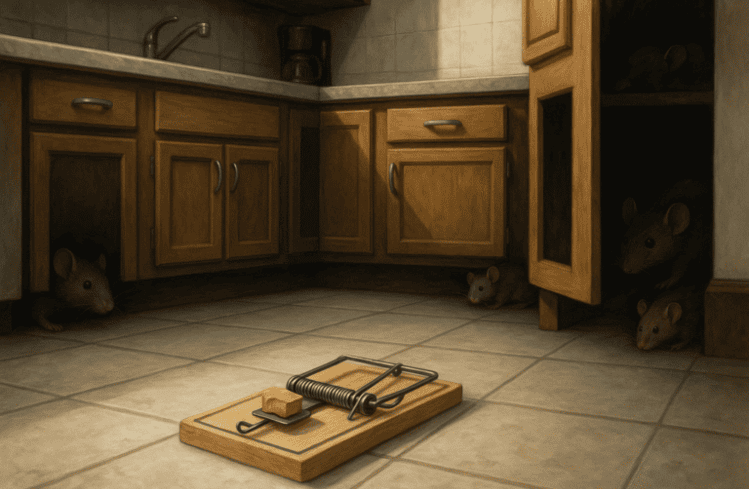“Why you still see mice after setting traps is a question many homeowners ask when dealing with infestations. A mouse problem can be frustrating, stressful, and even alarming. When homeowners notice signs of mice—such as droppings, gnawed wires, or scratching noises in the walls—the first instinct is often to set out a few traps. While mouse traps may catch a few rodents, traps alone won’t solve the problem in the long run. Mice are persistent, quick breeders, and remarkably resourceful at finding ways back inside your home.”
In this article, we’ll explore why traps are only a temporary fix, what makes mouse infestations so tricky, and the steps you can take for a more effective, long-term solution.
Why Traps Aren’t Enough
“1. Why You Still See Mice After Setting Traps: They Breed Faster Than You Think”
One of the biggest reasons traps don’t solve the problem is the sheer breeding speed of mice. A single female mouse can produce up to 10 litters per year, with each litter containing 5–12 pups. Even if you catch a few mice, dozens more may be hiding and reproducing in your walls, attic, or basement.
“2. Why You Still See Mice After Setting Traps: They’re Excellent at Hiding”
Mice are nocturnal and love dark, hidden spaces. They can nest inside insulation, behind cabinets, or even inside unused appliances. This is one of the main reasons why you still see mice after setting traps—a few traps won’t reach every area they’re nesting in. By the time you catch one, others are still lurking out of sight.
3. Mice Learn to Avoid Traps
Believe it or not, mice are cautious creatures. They may sniff out a trap and avoid it entirely, especially if they’ve seen other mice get caught. Some even manage to steal the bait without getting trapped. Relying on traps alone gives them time to adapt and multiply.
What Actually Works Against Mice
1. Seal Entry Points
The most important step in mouse control is prevention. Mice can squeeze through holes as small as a dime. Inspect your home carefully and seal cracks, gaps, and openings with steel wool, caulk, or metal mesh. This prevents new rodents from entering while you deal with the ones inside.
2. Keep Your Home Clean and Uninviting
Mice are drawn to food sources. Store pantry items in sealed containers, clean up crumbs quickly, and take out the trash regularly. Pet food should also be stored securely—otherwise, it’s like an all-you-can-eat buffet for rodents. Ignoring these steps is often why you still see mice after setting traps, since food sources keep attracting them back.
3. Use a Combination of Solutions
While traps can help reduce the visible population, they should be combined with bait stations, ultrasonic repellents, and professional pest control services. A multi-layered approach attacks the infestation from different angles, making it harder for mice to survive.
4. Professional Pest Control
Sometimes, the infestation is too big for DIY solutions. In such cases, calling a professional pest control company is the best option. Experts can identify entry points, place effective bait systems, and ensure your home is protected for the long term. Here’s an example of professional rodent control services you can explore.
Why Long-Term Prevention Matters
Even if traps reduce the current number of mice, new ones can always move in if your home remains accessible and inviting. By combining prevention, cleanliness, and professional solutions, you can create a long-term defense that traps alone simply cannot provide—this is the real reason why you still see mice after setting traps again and again.
Remember, your goal isn’t just to catch a few mice—it’s to make your home an environment where mice cannot survive or return.
Final Thoughts
Traps alone won’t solve your mouse problem because they only address the symptom, not the root cause. Mice breed rapidly, hide effectively, and adapt quickly. A holistic approach—sealing entry points, keeping your home clean, and working with pest control experts—is the only way to truly eliminate the issue and explains why you still see mice after setting traps despite multiple attempts.
By going beyond traps, you’ll protect not only your home but also your family’s health and peace of mind.
